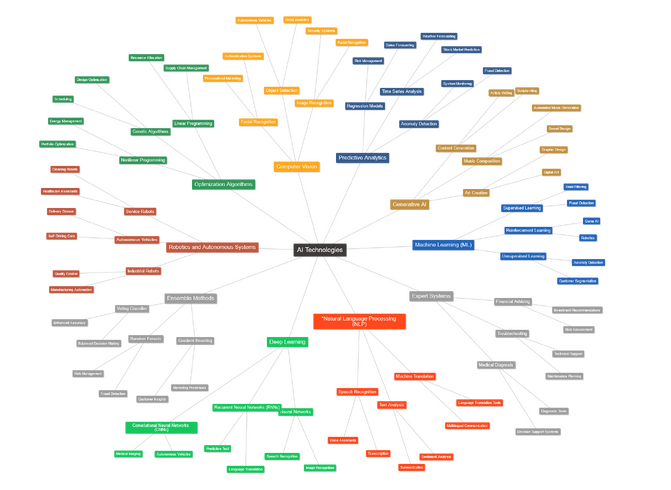Key AI Technology: Difference between revisions
(Created page with "thumb|671x671px|Key AI Technologies === Summary === The page provides an overview of various AI technologies, including Machine Learning (ML), Deep Learning, Natural Language Processing (NLP), Computer Vision, Predictive Analytics, Optimization Algorithms, Robotics, Generative AI, Expert Systems, and Ensemble Methods. Each technology is associated with specific applications and examples, showcasing the diverse capabilities of AI in areas...") |
No edit summary |
||
| Line 3: | Line 3: | ||
=== Summary === | === Summary === | ||
The page provides an overview of various AI technologies, including Machine Learning (ML), Deep Learning, Natural Language Processing (NLP), Computer Vision, Predictive Analytics, Optimization Algorithms, Robotics, Generative AI, Expert Systems, and Ensemble Methods. Each technology is associated with specific applications and examples, showcasing the diverse capabilities of AI in areas such as email filtering, fraud detection, image recognition, language translation, facial recognition, predictive analytics, robotics, art creation, content generation, medical diagnosis, financial advising, troubleshooting, and more. | The page provides an overview of various AI technologies, including Machine Learning (ML), Deep Learning, Natural Language Processing (NLP), Computer Vision, Predictive Analytics, Optimization Algorithms, Robotics, Generative AI, Expert Systems, and Ensemble Methods. Each technology is associated with specific applications and examples, showcasing the diverse capabilities of AI in areas such as email filtering, fraud detection, image recognition, language translation, facial recognition, predictive analytics, robotics, art creation, content generation, medical diagnosis, financial advising, troubleshooting, and more. | ||
You can click the image to the right, and click twice more to view it full size. | |||
=== Key Insights === | === Key Insights === | ||
| Line 25: | Line 27: | ||
==== What are some examples of robotics and autonomous systems? ==== | ==== What are some examples of robotics and autonomous systems? ==== | ||
Robotics applications include autonomous vehicles, industrial robots for manufacturing automation, service robots in healthcare, cleaning robots, and more. | Robotics applications include autonomous vehicles, industrial robots for manufacturing automation, service robots in healthcare, cleaning robots, and more. | ||
<nowiki>[[Category:Home]]</nowiki> | |||
Revision as of 02:20, 7 July 2024

Summary
The page provides an overview of various AI technologies, including Machine Learning (ML), Deep Learning, Natural Language Processing (NLP), Computer Vision, Predictive Analytics, Optimization Algorithms, Robotics, Generative AI, Expert Systems, and Ensemble Methods. Each technology is associated with specific applications and examples, showcasing the diverse capabilities of AI in areas such as email filtering, fraud detection, image recognition, language translation, facial recognition, predictive analytics, robotics, art creation, content generation, medical diagnosis, financial advising, troubleshooting, and more.
You can click the image to the right, and click twice more to view it full size.
Key Insights
- Machine Learning encompasses Supervised Learning, Unsupervised Learning, and Reinforcement Learning, each with distinct applications.
- Deep Learning involves Neural Networks like CNNs and RNNs for tasks such as image and speech recognition, language translation, and predictive text.
- NLP enables text analysis, speech recognition, and machine translation for various applications.
- Computer Vision includes image recognition, object detection, and facial recognition for security, retail analytics, and authentication.
- Predictive Analytics utilizes time series analysis, regression models, and anomaly detection for tasks like stock market prediction, sales forecasting, and fraud detection.
Frequently Asked Questions
What are some key applications of Machine Learning?
Machine Learning applications include email filtering, fraud detection, customer segmentation, game AI, robotics, and more.
How does Deep Learning differ from Machine Learning?
Deep Learning involves Neural Networks for complex tasks like image and speech recognition, while Machine Learning encompasses a broader range of algorithms and techniques.
What are some common uses of Natural Language Processing?
NLP is used for text analysis, sentiment analysis, speech recognition, language translation, and voice assistants.
What are some examples of robotics and autonomous systems?
Robotics applications include autonomous vehicles, industrial robots for manufacturing automation, service robots in healthcare, cleaning robots, and more.
[[Category:Home]]
